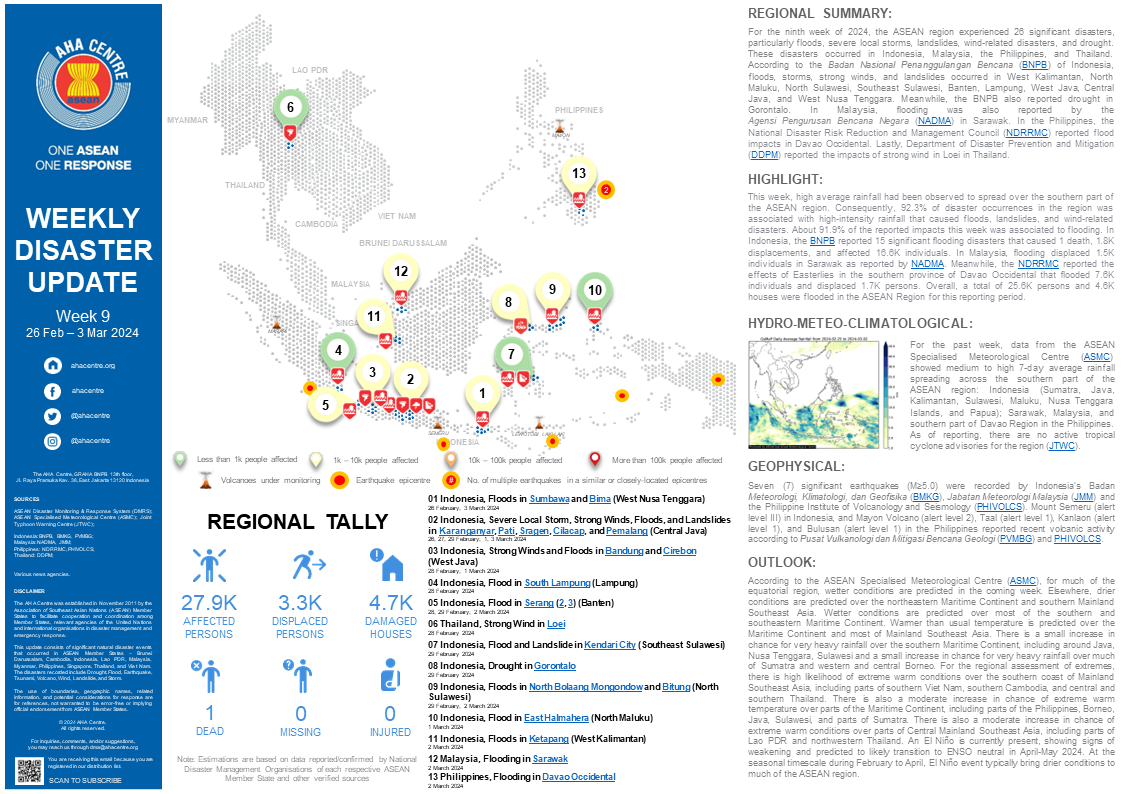
REGIONAL SUMMARY:
For the ninth week of 2024, the ASEAN region experienced 26 significant disasters, particularly floods, severe local storms, landslides, wind-related disasters, and drought. These disasters occurred in Indonesia, Malaysia, the Philippines, and Thailand. According to the Badan Nasional Penanggulangan Bencana (BNPB) of Indonesia, floods, storms, strong winds, and landslides occurred in West Kalimantan, North Maluku, North Sulawesi, Southeast Sulawesi, Banten, Lampung, West Java, Central Java, and West Nusa Tenggara. Meanwhile, the BNPB also reported drought in Gorontalo. In Malaysia, flooding was also reported by the Agensi Pengurusan Bencana Negara (NADMA) in Sarawak. In the Philippines, the National Disaster Risk Reduction and Management Council (NDRRMC) reported flood impacts in Davao Occidental. Lastly, Department of Disaster Prevention and Mitigation (DDPM) reported the impacts of strong wind in Loei in Thailand.
.
HIGHLIGHT:
This week, high average rainfall had been observed to spread over the southern part of the ASEAN region. Consequently, 92.3% of disaster occurrences in the region was associated with high-intensity rainfall that caused floods, landslides, and wind-related disasters. About 91.9% of the reported impacts this week was associated to flooding. In Indonesia, the BNPB reported 15 significant flooding disasters that caused 1 death, 1.8K displacements, and affected 16.6K individuals. In Malaysia, flooding displaced 1.5K individuals in Sarawak as reported by NADMA. Meanwhile, the NDRRMC reported the effects of Easterlies in the southern province of Davao Occidental that flooded 7.6K individuals and displaced 1.7K persons. Overall, a total of 25.6K persons and 4.6K houses were flooded in the ASEAN Region for this reporting period.
HYDRO-METEO-CLIMATOLOGICAL:
For the past week, data from the ASEAN Specialised Meteorological Centre (ASMC) showed medium to high 7-day average rainfall spreading across the southern part of the ASEAN region: Indonesia (Sumatra, Java, Kalimantan, Sulawesi, Maluku, Nusa Tenggara Islands, and Papua); Sarawak, Malaysia, and southern part of Davao Region in the Philippines. As of reporting, there are no active tropical cyclone advisories for the region (JTWC).
GEOPHYSICAL:
Seven (7) significant earthquakes (M>5.0) were recorded by Indonesia’s Badan Meteorologi, Klimatologi, dan Geofisika (BMKG), Jabatan Meteorologi Malaysia (JMM) and the Philippine Institute of Volcanology and Seismology (PHIVOLCS). Mount Semeru (alert level III) in Indonesia, and Mayon Volcano (alert level 2), Taal (alert level 1), Kanlaon (alert level 1), and Bulusan (alert level 1) in the Philippines reported recent volcanic activity according to Pusat Vulkanologi dan Mitigasi Bencana Geologi (PVMBG) and PHIVOLCS.
OUTLOOK:
According to the ASEAN Specialised Meteorological Centre (ASMC), for much of the equatorial region, wetter conditions are predicted in the coming week. Elsewhere, drier conditions are predicted over the northeastern Maritime Continent and southern Mainland Southeast Asia. Wetter conditions are predicted over most of the southern and southeastern Maritime Continent. Warmer than usual temperature is predicted over the Maritime Continent and most of Mainland Southeast Asia. There is a small increase in chance for very heavy rainfall over the southern Maritime Continent, including around Java, Nusa Tenggara, Sulawesi and a small increase in chance for very heavy rainfall over much of Sumatra and western and central Borneo. For the regional assessment of extremes, there is high likelihood of extreme warm conditions over the southern coast of Mainland Southeast Asia, including parts of southern Viet Nam, southern Cambodia, and central and southern Thailand. There is also a moderate increase in chance of extreme warm temperature over parts of the Maritime Continent, including parts of the Philippines, Borneo, Java, Sulawesi, and parts of Sumatra. There is also a moderate increase in chance of extreme warm conditions over parts of Central Mainland Southeast Asia, including parts of Lao PDR and northwestern Thailand. An El Niño is currently present, showing signs of weakening and predicted to likely transition to ENSO neutral in April-May 2024. At the seasonal timescale during February to April, El Niño event typically bring drier conditions to much of the ASEAN region.
Sources:
ASEAN Disaster Monitoring & Response System (DMRS); ASEAN Specialised Meteorological Centre (ASMC); Joint Typhoon Warning Centre (JTWC);
Indonesia: BNPB, BMKG, PVMBG;
Malaysia: NADMA, JMM;
Philippines: NDRRMC, PHIVOLCS;
Thailand: DDPM;
Various news agencies.







